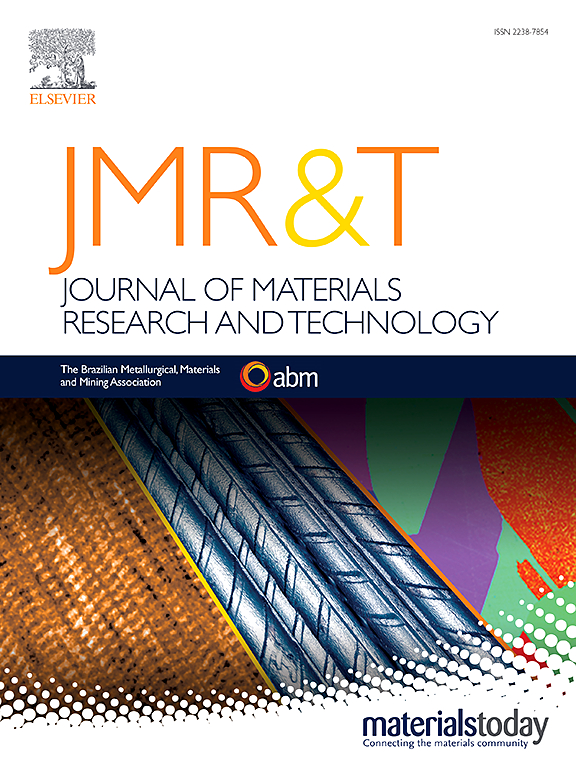Ni中间层增强DH32钢K-TIG焊接接头耐蚀性能的电化学和显微组织综合研究
IF 6.2
2区 材料科学
Q1 MATERIALS SCIENCE, MULTIDISCIPLINARY
Journal of Materials Research and Technology-Jmr&t
Pub Date : 2025-03-14
DOI:10.1016/j.jmrt.2025.03.126
引用次数: 0
摘要
焊接技术是现代制造业的重要支柱,特别是在造船和极端环境下的工程中。然而,焊缝的耐腐蚀性限制了其在腐蚀条件下的应用。这个问题在锁孔钨惰性气体(K-TIG)焊接中尤为明显,高热量输入通常会导致粗晶组织和成分偏析,从而降低耐腐蚀性。本研究系统地研究了不同厚度的镍(Ni)中间层对k - tig焊接DH32钢焊缝耐蚀性的影响,并探讨了其潜在的机制。开路电位、电化学阻抗谱、动电位极化等电化学测试结果表明,随着Ni含量的增加,焊缝腐蚀电位明显向正方向偏移。腐蚀电流密度降低到4.56 μA/cm2,电荷转移电阻增加了近3倍,达到1294.9 Ω⋅cm2,耐蚀性大幅提高。显微组织分析表明,Ni的加入细化了焊缝晶粒,使铁素体-珠光体组织转变为板条马氏体,形成富Ni晶界,提高了钝化膜的致密性和稳定性。腐蚀产物分析表明,高镍焊缝形成的混合氧化物(NiFe2O4)稳定性高,离子迁移速率低。这种致密的保护层大大降低了腐蚀反应的驱动力。综上所述,Ni微合金化通过优化K-TIG焊缝的组织、腐蚀产物的组成和电化学性能,提高了K-TIG焊缝的耐蚀性。本文章由计算机程序翻译,如有差异,请以英文原文为准。

Enhanced corrosion resistance of K-TIG welded DH32 steel joints with a Ni interlayer: A comprehensive electrochemical and microstructural investigation
Welding technology is a critical pillar of modern manufacturing, particularly in shipbuilding and engineering under extreme environments. However, the corrosion resistance of weld seams limits their application in corrosive conditions. This issue is especially pronounced in keyhole tungsten inert gas (K-TIG) welding, where high heat input often leads to coarse grain structures and compositional segregation, resulting in reduced corrosion resistance. This study systematically investigates the effect of nickel (Ni) interlayers with varying thicknesses on the corrosion resistance of weld seams in K-TIG-welded DH32 steel and explores the underlying mechanisms. Electrochemical testing, including open circuit potential, electrochemical impedance spectroscopy, and potentiodynamic polarization, reveals that with increasing Ni content, the corrosion potential of the weld seam shifts significantly in the positive direction. The corrosion current density decreases to 4.56 μA/cm2, while the charge transfer resistance increases nearly threefold to 1294.9 Ω⋅cm2, indicating a substantial enhancement in corrosion resistance. Microstructural analysis demonstrates that the addition of Ni refines the weld seam grains, transforming the ferrite-pearlite structure into lath martensite and forming Ni-enriched grain boundaries, which improve the compactness and stability of the passive film. Corrosion product analysis shows that high-Ni welds form mixed oxides (NiFe2O4) with high stability and low ion migration rates. This dense protective layer significantly reduces the driving force for corrosion reactions. In conclusion, Ni microalloying improves the corrosion resistance of K-TIG weld seams by optimizing the microstructure, composition of corrosion products, and electrochemical performance.
求助全文
通过发布文献求助,成功后即可免费获取论文全文。
去求助
来源期刊

Journal of Materials Research and Technology-Jmr&t
Materials Science-Metals and Alloys
CiteScore
8.80
自引率
9.40%
发文量
1877
审稿时长
35 days
期刊介绍:
The Journal of Materials Research and Technology is a publication of ABM - Brazilian Metallurgical, Materials and Mining Association - and publishes four issues per year also with a free version online (www.jmrt.com.br). The journal provides an international medium for the publication of theoretical and experimental studies related to Metallurgy, Materials and Minerals research and technology. Appropriate submissions to the Journal of Materials Research and Technology should include scientific and/or engineering factors which affect processes and products in the Metallurgy, Materials and Mining areas.
 求助内容:
求助内容: 应助结果提醒方式:
应助结果提醒方式:


